Human Flower Project
Walt Mayr: Nurseryman/Adventurer
Success in the nursery business requires risk-taking, curiosity, people-skills and tenacity. Success in the Alaskan nursery business took Walt Mayr.
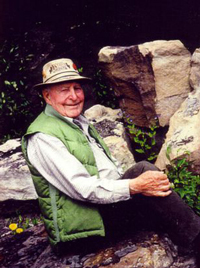 One of “the last true pioneers” of Alaskan horticulture, Walt Mayr (1914-2009)
One of “the last true pioneers” of Alaskan horticulture, Walt Mayr (1914-2009)
Photo: Courtesy of Nancy Fann
By Allen Bush
I’ve started reading the daily obituaries out of necessity rather than curiosity. The Kentucky writer Wendell Berry once said you end-up going to a lot funerals when you live in a small community. I’ve celebrated the passing, this past year, of two friends who lived long, wonderful lives. One was a North Carolina farmer, the other a Kentucky lawyer. It is a privilege to have a friend (in this case, the lawyer) who could laugh in his 95th year and ask, with a twinkle in his eye, “Why don’t we have a little something?” Meaning: Make mine a dry martini. Both wise men departed life on the wings of a dove. And though Phillip Roth said, “Old age isn’t a battle, it’s a massacre,” my friends left a legacy for growing older with grace. There wasn’t the slightest hint that old age was an inconvenience.
Walt Mayr, age ninety-five, passed away on August 10, 2009. I never met Walt. He lived far away in Sutton, Alaska. He was a skilled nurseryman who needed cultural questions answered when he first phoned me at Jelitto Perennial Seeds in Louisville, Kentucky.
We used to talk once a year and it didn’t take long to understand his genome was hotwired for curiosity. I didn’t have all the answers, but that didn’t matter. Figuring-out the best soil chemistry for growing plants is like rolling the dice on the periodic table. The best growers are a mixture of humility and doggedness. They work against great odds every year and know the deck is stacked. The most adventurous, and successful, are willing to try a few new plants every year along with their bread and butter inventory. They struggle to figure-out how to grow crops well, but that is one of the exciting parts of the adventure. Rare, indeed, is the grower who can keep the wolves from the door for over fifty years.

Walt Mayr delivering geraniums, always on time for Mother’s Day
Photo: Courtesy of the Mayr family
Since 1957 Walt had been a nursery owner who eventually specialized in perennials, but that doesn’t do the justice he deserves. It’s like saying Van Gogh’s best brushstrokes were blue. There was a whole lot more to Walt Mayr. Margaret Donatello of Alaska Mill and Feed in Anchorage fondly remembers the beautiful Martha Washington geraniums he used to deliver during the short six week selling season that began in mid-May. She was amazed that he could coax them into bloom on Mother’s Day, even when skies were gray.
There was a horticultural spark long before he arrived in Alaska. His youngest sister, Mildred Panconi of Castro Valley, California, remembers hollyhocks popping-up in their childhood farmyard of Earling, Iowa, and she wonders if this might have been his horticultural epiphany. Mildred thinks he might have planted them and recalls making doll’s skirts out of the cup shaped blooms. She remembers her older brother watching the progress of their asparagus bed and grape vines. After high school, Walt went to work in a greenhouse for his Uncle John Klaus in Greenwood, Missouri, near Kansas City, a job that made a lasting impression.
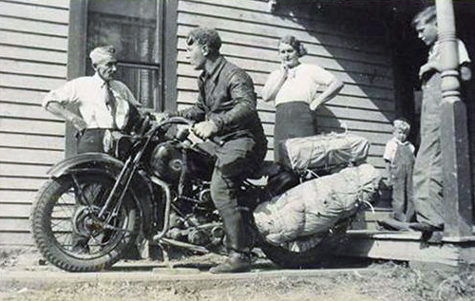
Looking for adventure, Walt says goodbye to his parents and brothers Al (at left) and Lambert.
Photo: Courtesy the Mayr family
Walt’s career was not a monastic life, alone with plants. He loved adventure beginning with a childhood trip, taken with an uncle, to Pikes Peak. Later, in 1938, Walt and a friend rode Harley-Davidsons from Earling, Iowa, to Hayward, California. He got a job at McClellan’s Greenhouses growing gardenias and roses. (Rod McClellan originated the gardenia corsage in 1937 and the company became known for orchids.) In 1942, Walt moved to Alaska, where he worked for thirty years as a millwright and mechanic in coal and gold mines. He also worked as a bush pilot flying friends to remote Alaskan hunting and fishing camps.
Fifteen years ago, when most everyone ordered by mail or phone, Walt began mailing or calling in small seed purchases to Jelitto Perennial Seeds. Now faxes, emails and online orders are the norm (though Jelitto would be perfectly happy if an order arrived carved on a stone tablet, carried on the back of a burro). The point is Walt wasn’t in a hurry, nor did he bother with new fangled things around the office. He was an outside sort of guy, anyway. (Technology has reduced nursery labor input and made communication faster, but there is no substitute for the experienced, guiding hand of a talented greenhouse or nursery grower.)
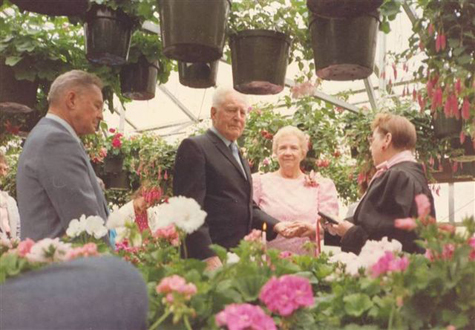
Walt and Elsie Mayr were married in the greenhouse surrounded by geraniums
May 15, 1988
Photo: Courtesy of the Mayr family
Direct contact with his customers was Walt’s preference, too. He grew the plants and delivered them around the Mat-Su Valley. I got the impression, with Walt’s annual calls to the Louisville office, that he liked knowing there was someone at the other end of the line, and I enjoyed being on the other end. We loved talking about plants. Our conversations opened-up a part of the world that had long intrigued me: I’ve held onto a magazine piece, “The Rush to the Klondike,” published in 1898 in American Monthly Review of Reviews. It was written by my great-grandfather about his trip to Alaska. He came back to Kentucky with a story and a few photos, but no gold, and no cure for wanderlust.
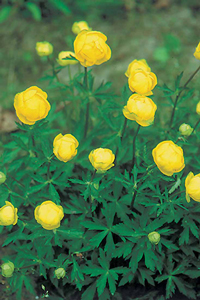 Trollius europaeus, European globe flower
Trollius europaeus, European globe flower
one of Walt Mayr’s specialties
Photo: Jelitto Perennial Seeds
Walt was described as, “the last of a true breed of pioneers”; the Alaska he first found in 1942 was a lot more rough-and-tumble than the state is now. I enjoyed learning more about Alaska, past and present, from him, for what grows in far-flung gardens fascinates me, too.
The wholesale nurseryman, described by friends as “generous and good hearted,” had a way with the European Globe Flower, Trollius europaeus. Midway down in the lower forty-eight, this buttercup relative always looked panic stricken in my garden by early summer—bedraggled and desperate for cooler nights. Walt kept nearly one hundred 5’ x 10’ outdoor stock beds (seven devoted to Trollius) covered with plastic and straw, winter protection that he removed as soon as there was a March thaw.
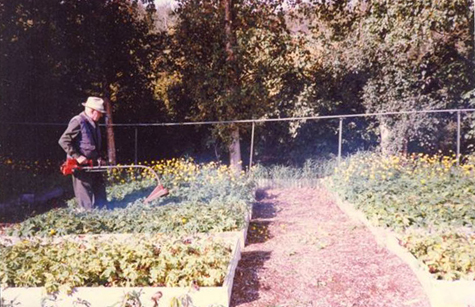
Mayr getting plants ready for the long Alaskan winter
Photo: Courtesy of the Mayr family
Penny Jane Fann of Amarillo, Texas, worked with Walt one summer and said, “He had developed a special technique that allowed them to flourish in Alaska. These Trollius, and hundreds of other plants, were sold throughout the Mat-Su as well as to greenhouses in Anchorage.” Penny added, “Walt was a wealth of knowledge and wisdom and was always coming up with new ideas for propagating plants and creating a wonderland of floral beauty.”
 Gentiana cruciata ‘Blue Cross’
Gentiana cruciata ‘Blue Cross’
Photo: Jelitto Perennial Seeds
Nancy McFarlane opened Danamac Acres Greenhouse in 1980, her family’s retail business in Palmer, a few miles from Mayr Greenhouse. Walt’s wife Elsie took the phone orders from McFarlane. If there were plant questions, she would yell them to Walt, who was a little hard of hearing. (Walt and Elsie were married in the Mayr Greenhouse on Mother’s Day in 1988.) The McFarlanes ordered 25-30 different perennials from Mayr including Tweedy’s Pussypaws, Lewisia tweedyi, another species all but hopeless in Louisville, where summer nighttime low temperatures in the 70s (not a good recipe for Lewisias) can exceed daytime highs in Alaska.
Walt’s last mail order arrived last January. It was an interesting order list, as always. I envy anyone who can grow Meconopsis x sheldonii ‘Lingholm’, the Himalayan Blue Poppy. Neither hope nor prayers are going to help me. I can only dream of these heavenly sky-blue flowers. He also ordered the new Gentiana cruciata ‘Blue Cross’ that grows only ten inches tall. I’m growing it, too. I germinated it at home last year and, rather than going downhill fast – as so many Gentians do – this one (a lime lover) grew magnificently in my scree garden. It’s a second year flowering species, now dormant and snow covered. I’d love to beat the odds and bring the dark blue bells into bloom this summer. I’ve got a good feeling that Walt Mayr will be smiling.

